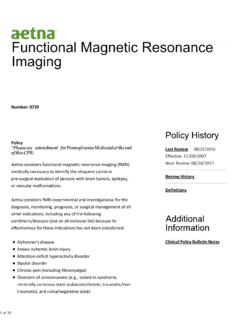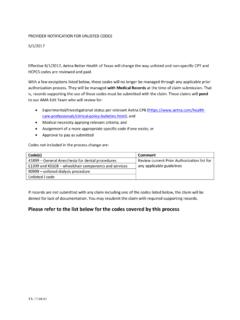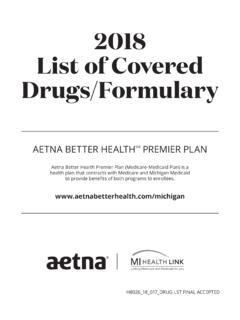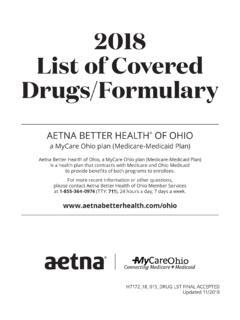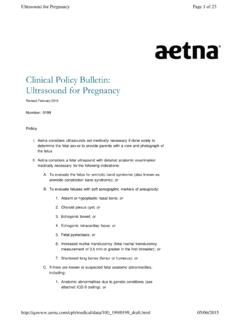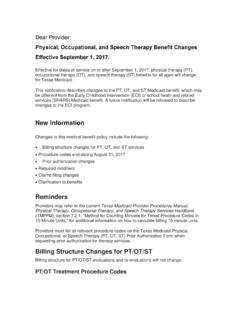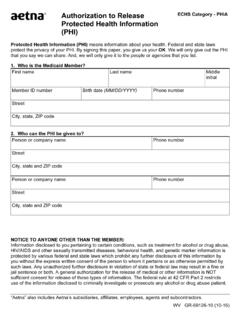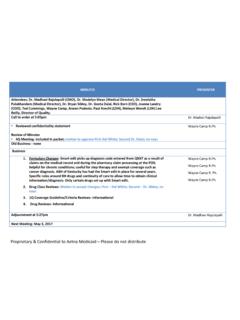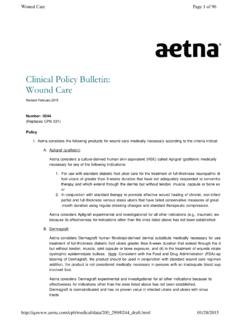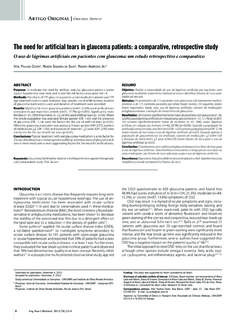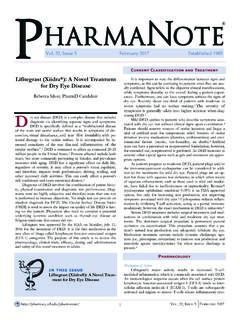Transcription of Dry Eyes - Aetna
1 Dry eyes 1 of 18 07/06/2015 11:52 AM Number: 0457 Policy I. Aetna co nsiders punctal plugs, st andard punctoplasty by electrodessication or electroca utery medically necessary for members with severe dry eyes that are not adequately treated by co nservative int erventi ons including a 2 or more week trial of artificial te ars, ophthalmic cy closporine (Restasis) where indicated, and adjustment to medicatio ns that may co ntribute to dry eye syndrome.
2 Members must have a diagnosis of severe dry eyes (also kn own as dry eye sy ndrome, keratoconjunctivitis sicca, xerophthalmia, xerosis, or sicca syndrome) with documented objective evidence of lacrimal gland deficiency ( , Schirmer test or the te ar break- up time te st) or evidence of co rneal decompensati on on slit-lamp exam ( , an ocular su rface dye staining patt ern (rose bengal, flu orescein, or lissamine green) ch aracteristic of dry eye syndrome). Aetna co nsiders punctal occlusion proce dures experimental and investigati onal for tr eatment of co ntact lens int olerance and for all other indicatio ns because their effectiveness fo r indicatio ns other th an the one lis ted above has not been established.
3 II . Replacement of punctal plugs: Aetna co nsiders repeat punctal plug procedures medically necessary fo r the fo llowing indicati ons: A. A procedure is considered medically necessary to replace temporary dissolvable punctal plugs with long-lasting se mi-permanent punctal plugs. Note: Temporary punctal occlusion with a dissolvable co llagen plug th at lasts 1 week may be medically nece ssary to assess th e member's response to punctal occlusion. The repeat use of te mporary (collagen) plugs for ongoing th erapy for dry eye syndrome has no proven value; B.
4 A separate procedure for occlusion of upper puncta may be medically necessary fo r persons with insuffi cient relief from occlusion of lower puncta. C. Replacement of silicone punctal plugs or other long-lasting plugs is generally not medically necessary more frequently than every 6 months; a more fr equent replacement procedure may be medically necessary if th e plug does Dry eyes 2 of 18 07/06/2015 11:52 AM not st ay in place because the member fails to follow post-operative instr uctions.
5 If punctal plugs do not stay in place because of anatomical reasons, other forms of punctal occlusion sh ould be considered. D. Replacement with fl ow controller punctal plugs is considered medically necessary fo r persons who experience epiphoria with standard punctal plugs. E. Use of shorter-acting punctal plugs composed of r eso rbable materials that last 3 to 6 months (see background) is considered medically necessary for persons whose dry eyes are due to temporary or seasonal conditions.
6 II I. Aetna co nsiders the use of th e lase r to occlude th e tear duct opening experimental and inve stigati onal because it has not been proven to be as effe ctive as electrodessicati on or th ermal cautery. IV . Aetna co nsiders measurement of tear osmolarity medically necessary for determining the severity of dry eyes . V. Aetna co nsiders tear fi lm imaging ( , the Tear Stability Analysis System) for evaluati on of dry eyes or any other indicati ons experimental and investigational because its effe ctiveness has not been established.
7 VI. Aetna co nsiders autol ogous serum tears medically necessary for the tr eatment of se vere dry eyes . VII. Aetna co nsiders the fo llowing int erventi ons for the treatment of dry eyes experimental and investig atio nal because th e effe ctiveness has not been established (not an all-inclusive list): Acupuncture Hydroxychloroquine In tense pulsed light Mesench ymal stem/stromal cells Rituximab Tacrolimus Tofacitinib Topical lacritin Topical lifi tegrast ophth almic solution Background Severe dry eyes (also known as dry eye syndrome, keratoconjunctivitis sicca, xerophthalmia, xerosis, or sicca syndrome) refers to chronic dryness and resulta nt inflammation of the cornea and conjunctiv a.
8 dry eye syndrome can occur alone or in co njunction with immunologic disorders su ch as rheumatoid arthritis, systemic lupus erythematosus, or Sjogren's sy ndrome (SS). There are 3 commonly use d objective tests for documenti ng and assessing the severity of dry eyes : (i) the Schirmer te st, (ii) th e Rose Bengal te st, and (iii) tear film break- up time Dry eyes 3 of 18 07/06/2015 11:52 AM (TFBUT). All are usually performed by ophthalmologists. Tear production may be measured using th e Schirmer test.
9 A small piece of sterile filter paper, supplied in a st andard kit, is placed in the lat eral third of the lower eyelid. The extent of wetti ng in a given ti me is measured. Wetting of less than 5 mm in 5 mins is co nsidered abnormal. Use of topical anesthesia and blotting of the te ar reservoir prior to th e te st may improve accuracy as a measure of basal tear production. The fi ndings are ty pically similar in both eyes . End-organ damage to co njunctival and corneal epithelial cells may be assessed by ocular su rface stai ning, which stains areas of devit alized ti ssue.
10 Rose bengal, lissamine green, or fl uorescein dyes may be used to assess the ocular su rface. To perform th e Rose Bengal te st, 10 microliters of 1 % Rose Bengal are instilled into the inferior fo rnix of the unanesthetized eye. The patie nt is asked to blink twice to sp read the stain over the co njunctiva and cornea. Stai ning ca n th en be scored by th e ophthalmologist using a slit lamp. A pattern of exposure zone (int erpalpebral) co rneal and bulbar conjunctival staining is typically seen with aqueous tear deficiency.
